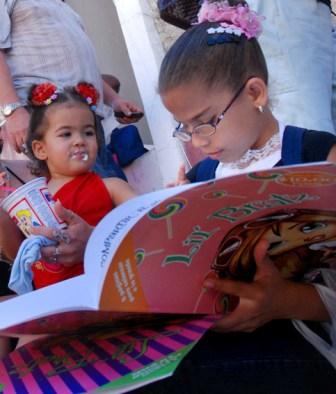Kids and “Bratz”

“Bratz” is the title of a series of books from abroad that present slender teenage girls of different skin tones and hairstyles, but with the same image of social success in a society very different from our own.
The politically correct “Bratz,” sold in CUCs (Cuba’s hard currency), were highly sought after by the parents of girls who attended the recently concluded Havana Book Fair.
It’s not that Cuban girls want to be like those “Bratz,” but that -despite the many efforts of intellectuals, educators, writers and artists from Cuba- apparently a compelling alternative is lacking.
A great deal of literature for children was sold at the fair. But since I don’t have children, I don’t usually pay it a lot of attention. However, did I notice one book designed for cutting out clothes and outfitting paper figures in the uniforms of the different provincial baseball teams of Cuba. Also available were numerous comic books, many of them with Latin American historical themes.
Nonetheless, when you see some of these books recently published for Cuban children -with very little text, and “artistic” illustrations that look distorted- you have to wonder what school children must think.
A few years ago at the fair, the classic tale of Pinocchio was presented in a book illustrated by a famous Cuban painter. I witnessed how some children actually cried when they saw the illustrations. I’m not exaggerating, nor criticizing to criticize; it’s that I just I remember how I was when I was a child (and in some ways still am)… and I think back to the books that I had.
My parents bought me books with many figures in color, and even in black and white – but those were for coloring. Many of these publications not only stimulated my imagination, but also my thought. I owe a lot to those books, to their creators, and to my parents who gave them to me.
I worry about this situation in the present digital age, whose full force has still not fully hit Cuba. I fear that children’s books may become less and less desired by kids, while electronic media will become vehicles for transmitting and reproducing consumerism and notions of status.
I saw a Chilean educator on TV talking about books for children, and the radical change that must occur. He spoke about the need to abandon didactical approaches (whereby kids are told to “read because it’s important”) and begin to stimulate them (directing them to “read because it’s entertaining”).
I agree with the Chilean. I believe that in Cuba we should take his words seriously, not only with regard to books, but also in connection to education overall.
In Cuba, we continue to conceive of knowledge as an obligation, or a duty, and not as a pleasurable practice – at least for most of the children whose experience in Cuban schools is like this.
I remember how I was shocked by the words of a teacher when I was eight. She said we should go to the Museum of Natural History because “it was very important.” I had my own reasons to go to the museum (the sable tooth tigers and the dinosaur skeleton!), but these had nothing to do with being “important”… though later I discovered that indeed it was.
My friend, Cuban essayist and poet Victor Fowler, has discerned a dichotomy in Cuba between “the body of pleasure” and “the body of the Homeland.” I believe that explains why the bodies of the “Bratz” are popular among Cuban girls.
But that doesn’t make the comic-strip character Elpidio Valdés any less popular. The little fighter for an independent homeland was created by maestro Juan Padron. Like him, there are many illustrators and writers who can help our children to be more intelligent, to study with desire and pleasure, to avoid -at least in their generation- as much the consumerism as the useless schizophrenia of the two bodies.

Kids must be hard-wired with a natural “bull-shit detection meter, ” whose alarm immediately goes off whenever an adult says that they must do something “because it is good for them, ” or because “it is important!” When my son and daughters were little I tried to slip in some “moral” children’s litereature every now and again. They invariably detected when a story was diluted by didacticism and immediately rebelled. Amongst their favorites, were the utterly unredeeming “Goose Bumps” series by R. L. Stine. After a while, I came to realize that he did not write all these stories himself, as their styles were so diverse, and I came to recognize which of his anonymous stable of storytellers had talent and style. Also, as I read these stories aloud to my children I was able to unleash the actor within me as I recreated the lurid scenes.
My daughters loved Barbies (for some reason, the Bratz never appealed to them), but I was successfully able to subvert this love by creating stories where Barbie and her pals turned sinister and malevolent (This, I must admit, was inspired by a series trashy horror films featuring a child’s doll which came to life to commit mayhem!) In any event, in both cases, my girls loved my stories, and I think this was the beginning of the process wherein they have subsequently developed a healthy sense of irony.